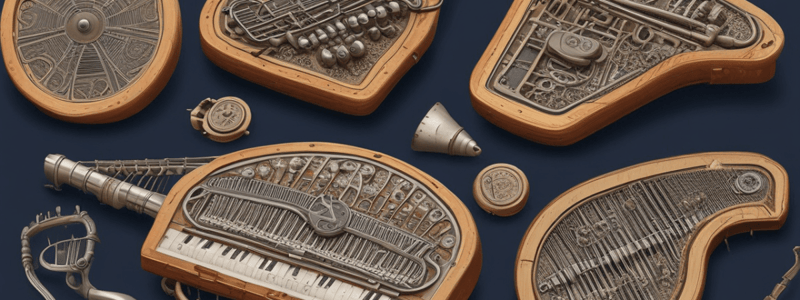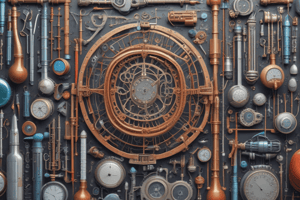Podcast
Questions and Answers
What is the definition of astronomical observation?
What is the definition of astronomical observation?
Astronomical observation is the detection of observational values of celestial objects or a stellar event via bare eyes or by using technical instruments.
What are some examples of technical instruments used in astronomical observation?
What are some examples of technical instruments used in astronomical observation?
Examples of technical instruments used in astronomical observation include telescopes, spectrographs, CCD cameras, photometers, and photographic plates.
What is the definition of an observatory?
What is the definition of an observatory?
An observatory is a place equipped with specific technical instruments for astronomical observation to observe celestial objects.
What are the different types of observatories mentioned in the text?
What are the different types of observatories mentioned in the text?
What is a key property of astronomical observations?
What is a key property of astronomical observations?
What other key property of astronomical observations is mentioned?
What other key property of astronomical observations is mentioned?
What is a spectrograph and how is it used in astronomical observation?
What is a spectrograph and how is it used in astronomical observation?
What is a CCD camera and how is it used in astronomical observation?
What is a CCD camera and how is it used in astronomical observation?
How does light pollution impact the view of the night sky?
How does light pollution impact the view of the night sky?
Why are migratory birds affected by light pollution?
Why are migratory birds affected by light pollution?
How does light pollution impact astronomical observations?
How does light pollution impact astronomical observations?
What is the purpose of this presentation?
What is the purpose of this presentation?
What course codes are mentioned in the presentation?
What course codes are mentioned in the presentation?
What is the name of the instructor for this course?
What is the name of the instructor for this course?
Where did Asst. Prof. Can GÜNGÖR complete his undergraduate and master's degrees?
Where did Asst. Prof. Can GÜNGÖR complete his undergraduate and master's degrees?
What was the focus of Asst. Prof. Can GÜNGÖR's PhD research?
What was the focus of Asst. Prof. Can GÜNGÖR's PhD research?
Where did Asst. Prof. Can GÜNGÖR obtain his PhD degree?
Where did Asst. Prof. Can GÜNGÖR obtain his PhD degree?
Where did Asst. Prof. Can GÜNGÖR work as a visiting researcher?
Where did Asst. Prof. Can GÜNGÖR work as a visiting researcher?
What is the warning given regarding the use of this presentation?
What is the warning given regarding the use of this presentation?
What is one of the most important information to record in astronomical observations?
What is one of the most important information to record in astronomical observations?
Why is the time and location of observation important for astronomical events?
Why is the time and location of observation important for astronomical events?
What is the scientific goal of an astronomer?
What is the scientific goal of an astronomer?
What is important for precise reductions in astronomical observations?
What is important for precise reductions in astronomical observations?
What is an observatory?
What is an observatory?
What are the different types of observatories mentioned in the text?
What are the different types of observatories mentioned in the text?
What is the Turkish National Observatory?
What is the Turkish National Observatory?
What is light pollution?
What is light pollution?
What is one important factor to consider when choosing a location for an astronomical observatory?
What is one important factor to consider when choosing a location for an astronomical observatory?
What meteorological condition needs to be considered for good astronomical observation?
What meteorological condition needs to be considered for good astronomical observation?
What atmospheric properties related to water vapor should be accounted for?
What atmospheric properties related to water vapor should be accounted for?
Besides humidity, what other atmospheric particles can affect astronomical observation?
Besides humidity, what other atmospheric particles can affect astronomical observation?
What type of pollution should be minimized at an observatory site?
What type of pollution should be minimized at an observatory site?
What wind-related parameter is important for site selection?
What wind-related parameter is important for site selection?
What atmospheric condition directly affects image quality and must be less than 1 arcsecond?
What atmospheric condition directly affects image quality and must be less than 1 arcsecond?
What phenomenon related to atmospheric turbulence needs to be profiled for adaptive optics?
What phenomenon related to atmospheric turbulence needs to be profiled for adaptive optics?
If an observatory has excellent 'seeing', what does that indicate about the atmosphere?
If an observatory has excellent 'seeing', what does that indicate about the atmosphere?
Why is it important to obtain turbulence profiles along height for an observatory?
Why is it important to obtain turbulence profiles along height for an observatory?
Flashcards are hidden until you start studying




